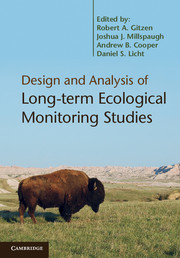Book contents
- Frontmatter
- Contents
- List of contributors
- Foreword: Ecology, management, and monitoring
- Preface
- Acknowledgments
- Abbreviations
- Section I Overview
- Section II Survey design
- Section III Data analysis
- Section IV Advanced issues and applications
- Section V Conclusion
- 22 Institutionalizing an effective long-term monitoring program in the US National Park Service
- 23 Choosing among long-term ecological monitoring programs and knowing when to stop
- References
- Index
- Plate Section
23 - Choosing among long-term ecological monitoring programs and knowing when to stop
Published online by Cambridge University Press: 05 July 2012
- Frontmatter
- Contents
- List of contributors
- Foreword: Ecology, management, and monitoring
- Preface
- Acknowledgments
- Abbreviations
- Section I Overview
- Section II Survey design
- Section III Data analysis
- Section IV Advanced issues and applications
- Section V Conclusion
- 22 Institutionalizing an effective long-term monitoring program in the US National Park Service
- 23 Choosing among long-term ecological monitoring programs and knowing when to stop
- References
- Index
- Plate Section
Summary
Introduction
Long-term ecological monitoring is generally considered an essential tool for the effective management of biodiversity (Strayer et al. 1986, Lindenmayer and Likens 2010a). There is a large body of scientific literature describing why long-term ecological monitoring is important and describing sophisticated and useful approaches for conducting it. In this chapter, however, we ask two slightly different and somewhat controversial questions. First, how do we identify which long-term ecological monitoring programs are more worthwhile than others? There are limited resources to fund monitoring and choices must be made. Second, how do we know when we should stop monitoring, if ever? So few examples of successful long-term monitoring exist that the idea of stopping monitoring sounds like heresy, but if the benefits are diminishing and the effort could be better used elsewhere, why not? To answer these questions we need to be able to classify and quantify the benefits of long-term monitoring and hence we pull together many of the ideas on this issue from the literature and other chapters in this book.
Monitoring has well-known benefits and is likely to play an increasingly important role as we try to determine how large-scale anthropogenic changes, in the context of a rapidly changing climate, alter the way in which we should manage ecosystems (Balmford et al. 2005, Field et al. 2007). Effective monitoring is a critical link in the cycle of adaptive management that aims to iteratively improve conservation actions over time (Holling 1978, Walters 1986) and is important for influencing government policy and investment in environmental programs (GAO 2006, OECD 2006).
- Type
- Chapter
- Information
- Design and Analysis of Long-term Ecological Monitoring Studies , pp. 498 - 508Publisher: Cambridge University PressPrint publication year: 2012
- 4
- Cited by

